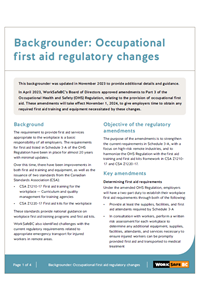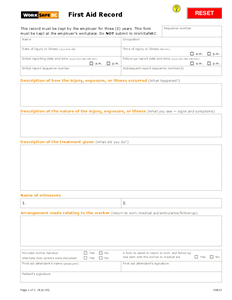First aid requirements
Employers are responsible for first aid in the workplace. To determine the first aid needs of your workplace, first you'll need to do an assessment. Then, you can review the findings and take necessary steps to put proper first aid procedures in place. If you're an employer, you are responsible for first aid in the workplace.
New first aid requirements come into effect November 1, 2024
In April 2023, WorkSafeBC’s Board of Directors approved amendments to Part 3 of the Occupational Health and Safety Regulation relating to provision of occupational first aid. These amendments take effect November 1, 2024. To assist employers in preparing for the approved amendments, we have added further guidance to the Backgrounder: Occupational first aid regulatory changes.
- Conducting a first aid assessment
- Developing first aid procedures
- Resources
First aid in the workplace is about providing workers with prompt, easily accessible, and appropriate first aid treatment. Depending on your workplace, some or all of the following might be needed:
- Occupational first aid attendants with the training appropriate for the type of workplace, number of workers, and time to a hospital.
- Proper facilities, such as first aid rooms or dressing stations.
- First aid kits with appropriate types and quantities of supplies.
- A record-keeping system so incidents can be logged.
- Appropriate means of transporting injured workers to medical aid.
- Effective means of communication between first aid attendants and workers served, and for the first aid attendant to call for assistance.
Conducting a first aid assessment
To determine an adequate and appropriate level of first aid coverage, the first step is a first aid assessment. This doesn't need to be complicated. But it does call for a full review of your workplace. The assessment will help you determine the minimum level of first aid needed in your workplace. First aid levels are outlined in the OHS Regulation Schedule 3-A: Minimum Levels of First Aid.
Steps to first aid assessment
-
1
Identify the number of workplaces
First aid coverage should be based on the total workforce present at each workplace. If your assessment determines you have multiple workplaces, you must complete an assessment for each location.
-
2
Identify your workplace hazard rating
First aid coverage is also determined by your workplace hazard rating. This rating reflects the nature and extent of the risks and hazards in your workplace. WorkSafeBC uses three levels of hazard ratings: low, moderate, and high. You can find your rating on the classification unit description sent out every year or look up your classification unit online.
-
3
Consider the surface travel time to a hospital
The level of first aid service required changes if it would normally take more than 20 minutes to safely transport an injured worker to hospital by road or water.
-
4
Determine the number of workers on a shift
Different shifts may have different requirements. Be sure to account for all workers who may require first aid during a shift.
-
5
Determine the required first aid services for your workplace
By referring to the OHS Regulation and supporting Guidelines and consulting appropriate WorkSafeBC resources (see Forms and Resources below), you can best determine what first aid kits, facilities, emergency vehicles, and equipment you need.
-
6
Review your assessment
Review steps 1 through 5 within one year of completing your assessment, or when there is a significant change in operations.
Developing first aid procedures
You are responsible for keeping up-to-date written first aid procedures at your workplace. As an employer, it's also your responsibility to ensure all workers know where first aid is located and how to call for it. To help you develop and keep your workplace first aid procedures current, consider:
- Drills — Conduct a drill at least once a year. This drill should test your workers' awareness of how to call for first aid, how well the communication system works, and the ability of first aid attendants to respond. It will also help you determine if your first aid services are adequate to deal with injuries and illnesses most likely to happen in your workplace.
- Maintaining the system — Consider assigning a worker to manage the first aid services at your workplace. His or her duties should include ensuring that required first aid attendant(s), supplies, facilities, and equipment are always available.
Highlights:
- Occupational first aid regulatory change: March 2024 update Published on: March 05, 2024


